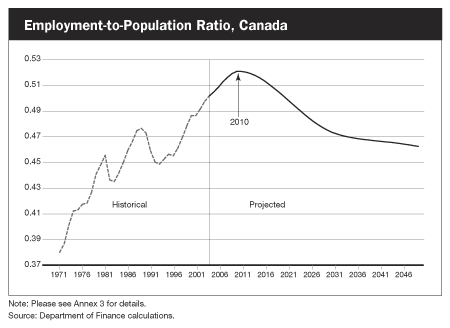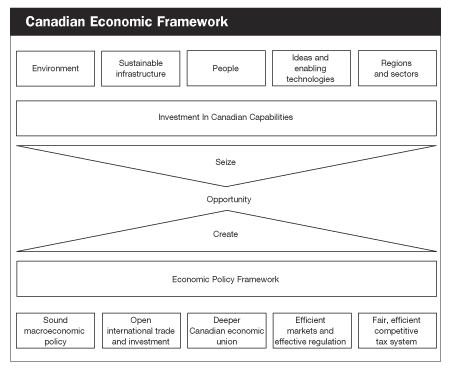![]()
Budget 2005 - Budget Plan
- Table of Contents - Previous
- Next -
Chapter 4
A Productive, Growing and Sustainable Economy
Highlights
Investments in Canadian Capabilities
Investing in People
Building on investments made by the Government of Canada in recent budgets, Budget 2005 makes significant strategic investments in building a highly skilled and adaptable workforce.
- $5 billion over five years to start building a framework for an Early Learning and Child Care initiative in collaboration with provinces and territories.
- An additional $120 million over five years to improve the Special Education Program for First Nations children living on reserve.
- $398 million over the next five years to enhance settlement and integration programs and improve client services for newcomers to Canada.
- $125 million over the next three years for next steps for the Workplace Skills Strategy.
- $30 million over three years to the National Literacy Secretariat.
Investing in Ideas and Enabling Technologies
Budget 2005 makes major strategic investments in building a world-class research environment in Canada through measures such as:
- $375 million over five years for the three federal research granting councils.
- $165 million to Genome Canada to sustain its support for breakthrough genomics research.
- $126 million over five years to support groundbreaking research in particle physics at the University of British Columbia’s TRIUMF science facility.
- $75 million over five years to help meet the indirect costs of federally supported reseach at hospitals and universities.
Investing in Regions and Sectors
Budget 2005 helps strengthen the economies of Canada’s regions through initiatives, including:
- Increased funding of $800 million for regional economic development agencies in Atlantic Canada, Western Canada, Quebec and Northern Ontario.
- $120 million towards the development of a comprehensive Northern Strategy for economic development.
- Additional investments in key sectors of Canada’s economy such as agriculture and space.
Economic Policy Framework
A Fair and Competitive Tax System
Budget 2005 reduces taxes for individuals—especially low- and modest-income Canadians. It will also promote economic growth by making Canada’s tax system more efficient and competitive. Under the measures set out in the budget:
- The amount of income that all Canadians may earn without paying federal income tax will increase to $10,000. 860,000 taxpayers will be removed from the tax rolls, including about 240,000 seniors.
- RRSP annual contribution limits will be increased to $22,000 and corresponding increases made for employer-sponsored registered pension plans.
- The corporate surtax will be eliminated and the 21-per-cent general corporate income tax rate will be reduced to 19 per cent, maintaining our tax rate advantage relative to the U.S.
- Capital cost allowance rates will be better aligned with the useful life of assets.
More Efficient and Effective Markets
To improve Canada’s business climate, Budget 2005 commits the Government to:
- Eliminate the 30-per-cent foreign property limit on pension investments.
- Increase deposit insurance coverage to $100,000 from $60,000.
- Consult with Canadians on refinements to the legislative framework for the financial sector to improve consumer protection and promote greater efficiency.
- Work with the provinces and territories to reach an agreement by year-end on an enhanced system of securities regulation.
- Introduce regulatory reforms and other initiatives that will advance Canada’s record of strong economic growth and job creation.
Introduction
A central role of government is to improve the well-being of all Canadians. A 21st century economy—a dynamic economy that creates opportunities for its people and is environmentally sustainable—is essential for achieving this objective. A productive, growing economy not only provides the foundation for more jobs and rising incomes, but also provides resources for investment in the quality of life of Canadians.
Improving Canadians’ well-being requires a balanced mix of policy actions that together create a sustainable approach to meeting Canada’s social, environmental and economic goals. A dynamic and sustainable economy ensures that Canada’s leading record of economic growth continues, that growth today does not come at the expense of negative consequences tomorrow, and that Canada has the resources to secure social goals and meet global responsibilities.
This chapter builds on a track record of success to meet new challenges and to seize global opportunities.
Addressing Canada’s Foremost Economic Challenges
Improving the living standards of Canadians can be achieved in two ways: through greater employment as a proportion of the population and higher productivity. Greater employment increases living standards as more of the population produces and earns income. Higher productivity increases living standards as each employed person produces and earns more.
For almost a decade, Canada has been successful in raising living standards by increasing both employment and productivity. As described in Chapter 2, since the federal budget was balanced in 1997–98, Canada’s standard-of-living growth has been the best of all the Group of Seven (G-7) leading industrial nations, including the United States. As described in Chapter 7, this government has no intention of going back into deficit.
Canada’s outstanding performance must not be taken for granted, particularly in the light of new challenges. In the short term, Canadian businesses must continue to adjust to the increased value of the Canadian dollar. Over the longer term, Canada needs to meet the twin challenges of intensifying global competition and impending demographic change while striving to reduce its environmental footprint. The Government of Canada’s best response to these challenges—the best way to increase national well-being—is to improve Canadian productivity through an emphasis on new skills and knowledge, increased physical investment, effective markets and commercial innovation.
Canada must respond to its impending demographic challenge. As noted by the Organisation for Economic Co-operation and Development (OECD), "looking forward, the key challenge for Canada will be to set policies in a way that ensures continued strong growth in living standards, despite the passage of the baby boomers into retirement."[1] As described in more detail in Annex 3, Canada’s aging population means that the number of working-age people will shrink as a share of the whole population. This has significant economic, as well as social, implications. With the coming demographic shift, higher employment will no longer be a reliable source of improvement in living standards. In fact, the anticipated fall in the share of the population in employment over the coming decades, shown in the chart below, could act as a drag on the growth of Canadians’ standard of living.

Much can still be done to mitigate this process and sustain
employment. Priorities include boosting job opportunities for Aboriginal
people, and improving and accelerating the integration of new Canadians,
especially those who are highly skilled, into the workforce. These are clear
examples of how positive social and economic policies can be mutually
reinforcing. In an aging society, Canada should also ensure that older
Canadians who wish to continue to take part in the labour market are able to do
so. Nonetheless, in the long run, a decline in the proportion of working
Canadians in the population is inevitable. This means that for continued growth
in Canada’s living standards and to obtain the resources to meet the needs of
an aging population, the critical task facing Canada is to increase
productivity by investing in the drivers of economic growth.
Canada’s Economic Policy Framework
To address these challenges the Government of Canada is pursuing a two-fold economic strategy. First, it will continue to build the Canadian economic framework, which creates domestic and global opportunities for Canadians and Canadian business. Second, it will continue to invest in Canadian capabilities, the drivers of our economic growth. The combination of the right framework policies and sustained investment in Canada’s capabilities create sustainable economic growth, which is essential to improve the well-being of all Canadians.
Sound macroeconomic policy—which includes low and stable inflation, prudent fiscal planning, balanced budgets, and falling government debt—is central to Canada’s economic policy framework. To be fully effective, this sound macroeconomic policy must be complemented with effective structural policies. These include free trade, a deeper Canadian economic union, efficient markets and a competitive tax system. As one of the world’s leading trading nations, Canada has a vital stake in a free and open economy, both domestically and internationally. Free trade not only provides better access to large foreign markets, but also the necessary competitive environment, and the incentives, for firms to adopt the latest advances in technology.
Canada has also benefited immensely from other forms of structural reform, including the promotion of competition, and more efficient regulation. Budget 2005 provides important framework initiatives, including making key markets more efficient and building a fairer and more internationally competitive tax system.

A fair, efficient and competitive tax system represents a critical foundation for a productive economy. Reductions in personal taxes provide greater incentives for individuals to work, save and invest in their skills and education. Reductions in corporate taxes increase incentives for firms to invest in new equipment, undertake innovative research, and continue to create jobs.
Rules and regulations are essential to safeguard the health and safety of Canadians. Appropriate regulations do not place unnecessary burdens on Canadians, freeing investment and interprovincial flows of people and commerce. Budget 2005 takes a series of measures to improve the efficiency of our markets, particularly the financial markets. Financial markets play an important role in allocating resources to firms with the best investment opportunities. By making them more efficient, both the returns to Canadian savers and the international competitiveness of our businesses will increase.
The Canadian economic framework creates opportunities for all Canadians. Together, these policies provide the right economic policy framework for individuals and firms to invest in the key drivers of growth: human capital, physical capital and innovation. To seize these opportunities, the Government of Canada must also invest in Canadian capabilities that support these growth drivers. In this budget, the Government continues to enhance and strengthen Canada’s core capabilities by:
- Investing in people.
- Investing in ideas and enabling technologies.
- Strengthening the ability of regions and sectors to compete at the leading edge.
1 OECD Economic Surveys: Canada, 2004, p. 37. [Return]
- Table of Contents - Previous - Next -
|
|
|||||
| Last Updated: 2005-02-23 |
| ||||